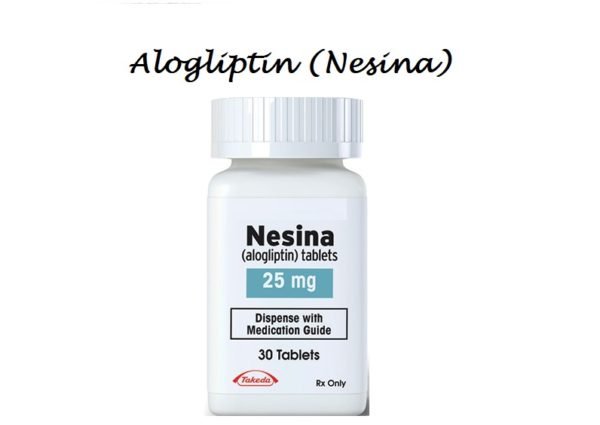Alogliptin is an oral anti-diabetic medicine of the DPP IV class. It increases the half-life of endogenous incretins resulting in blood sugar reduction. It causes a glucose-dependent reduction in blood sugars and does not result in insulin secretion if the blood sugars are less than 90 mg/dl. It may be used as monotherapy or in combination with metformin, pioglitazone, sulfonylureas or insulin. It is weight neutral i.e. does not cause weight gain and does not increase the risk of heart disease.
Alogliptin safety in atherosclerotic cardiovascular diseases:
Alogliptin added to metformin and sulfonylureas in patients with a recent acute coronary syndrome resulted in better outcomes in terms of glycemic control and lower mortality rates [Ref]. However, the EXAMINE trial that was conducted in diabetic patients with acute coronary syndrome showed that alogliptin had no effect on the cardiovascular atherosclerotic endpoints. However, patients who did not have a history of heart failure at baseline, there was an increased incidence of hospitalization due to heart failure [Ref].
Alogliptin is contraindicated in patients with the following conditions:
- Allergy to alogliptin. Serious allergic reactions including Steven Johnsons syndrome, exfoliative dermatitis, anaphylaxis, urticaria, and angioedema have been reported.
- Pancreatitis
- Severe liver disease
- Diabetic ketoacidosis
- Burns, infections, and trauma
- Gastrointestinal diseases like gastroparesis, diarrhea, and vomiting
- Severe renal or cardiac disease
- Patients at-risk of hypoglycemia like those with adrenal and thyroid disease
- Pregnancy and lactation, and
- Patients with Joint diseases
Alogliptin Dose in Adults
Alogliptin dosage:
25 mg once daily. (Maximum dose: 25 mg once daily). The dose should be reduced in patients with renal disease and patients using sulfonylureas, pioglitazone or insulin.
Alogliptin Dose in Children
It is not recommended for use in infants and children
Alogliptin dose in kidney disease:
Creatinine clearance of:
-
greater than 60 ml/min:
- No dose adjustment is necessary
-
30 to 60 ml/min:
- 12.5 mg once daily
-
less than 30 ml/min and patients on intermittent hemodialysis:
- 6.25 mg once daily
Alogliptin Dose in Liver Disease:
- Patients with mild to moderate liver disease, or CHILD classes A and B, do not require a dose change.
- The drug has not been studied in patients with severe liver disease. It should be used with caution in these patients.
How to Administer Alogliptin?
It may be taken with or without meals.
Pregnancy Category C
It has not been tested in nursing diabetic women or in pregnant women. Insulin has been recommended by many authorities, including the American College of Gynecologists (ACG) and the American Diabetes Association (ADA).
Alogliptin (Nesina) Side effects (Severe):
Rapid: Anaphylactoid reactions, angioedema,
Delayed: Stevens-Johnson syndrome, pancreatitis, pemphigus, serum sickness, ileus, hepatic failure, heart failure, and renal failure
Nesina less severe side effects:
Early: Hypoglycemia and Bullous rash
Delayed: Elevated hepatic enzymes and constipation
Nesina mild side effects:
Rapid: Urticaria,
Early: Headache, Rash, nausea, and diarrhea
Delayed: Pharyngitis, infection, and arthralgia
Alogliptin MOA (Mechanism of action):
- Alogliptin (dipeptidyl peptidase IV inhibitor) is called Alogliptin.
- This enzyme cleaves and inactivates incretins. Incretins, hormones that the intestines secrete in response to eating, are hormones.
- GLP-1 (glucagonlike peptide 1), and GIP (glucose dependent insulinotropic peptide) are the two main incretin hormones.
- Both incretins increase insulin secretion and reduce hepatic glucose generation. It is almost 100% bioavailable orally and does not absorb well from meals.
Alogliptin Brands in Pakistan:
No brands available in Pakistan
International brands of alogliptin:
Nesina







